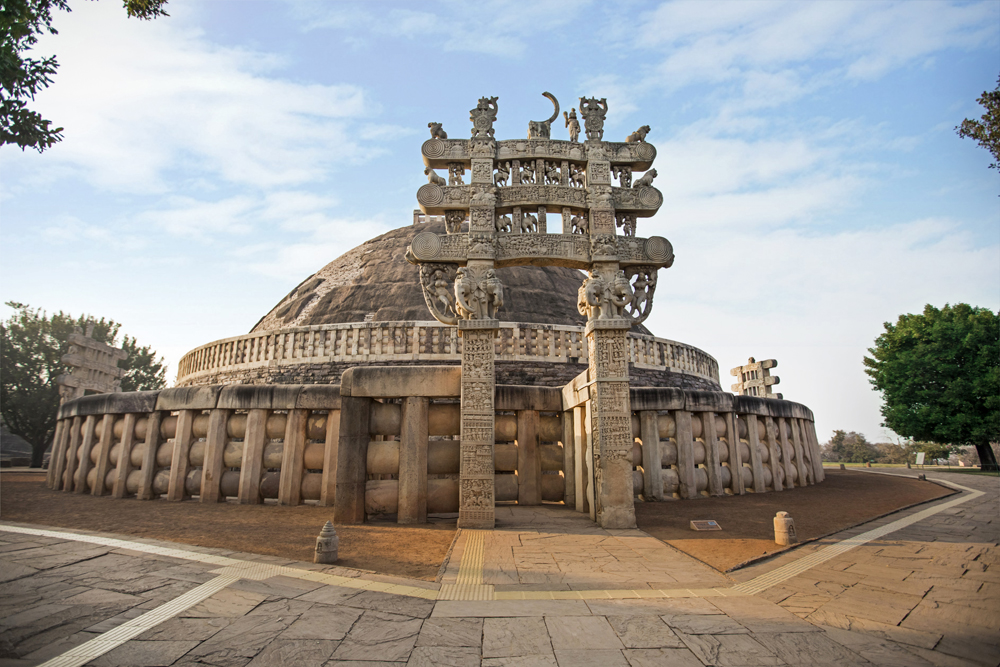Sanchi Stupa: An Ancient Marvel’s Path to World Heritage Status
Nestled atop a serene hill in Madhya Pradesh, the Sanchi Stupa stands as a testament to India’s rich cultural heritage and spiritual legacy. Recognized as a UNESCO World Heritage Site, this ancient monument has not only withstood the test of time but has also captured the world’s imagination with its profound historical significance and architectural elegance. In this article, we delve into the historical journey, the path to World Heritage recognition, the reasons behind its designation, and the lasting impact of the Sanchi Stupa.

A Glimpse into History:
The Sanchi Stupa, dating back to the 3rd century BCE, is a marvel of Buddhist architecture. Commissioned by Emperor Ashoka, it served as a significant center of pilgrimage and worship for Buddhists. Over time, the site expanded to include additional stupas, monasteries, and intricate carvings that collectively narrate the story of Buddhism’s evolution.
Date of Designation:
The Sanchi Stupa achieved its UNESCO World Heritage status on November 30, 1989. This recognition marked a pivotal moment in acknowledging the monument’s global significance as an architectural and cultural treasure.
Reasons Behind its Designation:
Several compelling reasons contributed to the inclusion of the Sanchi Stupa in the UNESCO World Heritage List:
- Architectural Elegance: The Sanchi Stupa showcases exceptional craftsmanship and design. Its circular structure, elegant gateways (toranas), and intricately carved balustrades are masterpieces of ancient Indian artistry.
- Spiritual Significance: As one of the most important pilgrimage sites for Buddhists, the Sanchi Stupa holds immense spiritual value. It symbolizes the teachings of Buddha and serves as a place of meditation and reflection.
- Historical Legacy: The monument preserves historical insights into the development of Buddhist art and architecture. The carvings depict scenes from Buddha’s life, illustrating the evolution of his teachings and the spread of Buddhism.
- Cultural Exchange: The carvings also reflect the multicultural influences of the time, showcasing interactions between Indian, Greek, and other artistic traditions. This convergence of styles underscores Sanchi’s role as a crossroads of cultural exchange.
Impact of World Heritage Status:
The UNESCO World Heritage recognition has left an indelible impact on the Sanchi Stupa and its surroundings:
- Conservation and Restoration: The designation has spurred concerted efforts to conserve and restore the monument, ensuring its preservation for future generations. Conservation projects address issues such as weathering, erosion, and structural stability.
- Tourism and Education: The World Heritage status has amplified tourism to Sanchi, drawing visitors eager to explore its historical and spiritual significance. This influx supports local economies and educates visitors about India’s rich cultural heritage.
- Cultural Awareness: The designation serves as a catalyst for global awareness about the importance of safeguarding cultural and historical treasures. It fosters dialogue about the significance of ancient sites in understanding our shared human history.
Conclusion:
The Sanchi Stupa’s journey to becoming a UNESCO World Heritage Site is a tribute to its enduring cultural and spiritual significance. As it continues to stand as a beacon of ancient wisdom and artistic brilliance, the monument inspires awe and reverence, reminding us of the importance of preserving our heritage for future generations and fostering cross-cultural understanding.




